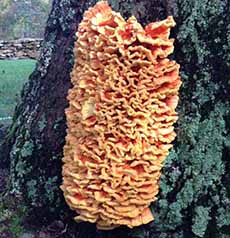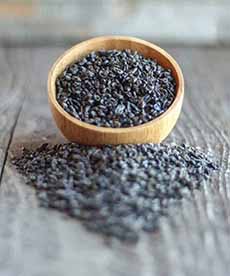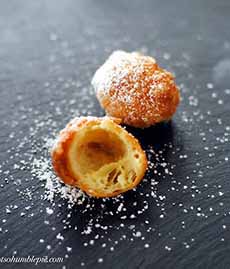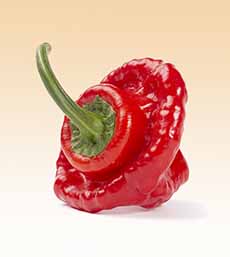|
Some foods in the English language are not as they appear. Here’s a list of some 44 food names that have amused us over the years. Note that in other countries, their names in the local language will be different. We’ve bypassed some well-known names like ants on a log, bear claws, chicken fingers, Buffalo wings, grasshopper pie, puppy chow candy; foods shaped like animals like bear claw and beavertail pastries; and some poetically-named Asian dishes like Ants Climbing A Tree*…which themselves may merit inclusion here at some future date.
Albany Beef: A slang term for sturgeons, which were once abundant in the Hudson River which flows through Albany County, New York).
Blood Pudding: (photo #1) Don’t expect dessert. This is what Americans call blood sausage. Blood sausages date to 800 B.C.E., where a mention of black pudding (another name for blood pudding) appears in Homer’s “The Odyssey.” They are believed to be the oldest form of sausages. Casings are filled with blood that is cooked or dried and mixed with a filler (bread, cereal, nuts) until it is thick enough to solidify when cooled. “Blak podyngs” were first recorded in the U.K. around 1450. The term “pudding” is Britain; ground meat steamed in a casing was called a pudding.
Bombay Duck: Is neither from Bombay nor duck. It is a type of lizardfish, a food fish that is also called bummalo, boomlaor bombil in the Indo-Pacific region. It got its name in the days of the Raj, from being transported on an iconic train, the Bombay Daak (daak is the Hindi word for mail). The British thus called the fish Bombay duck.
Bubble and Squeak: Nothing to do with sparkling wine and cheese (think mouse), this is a breakfast of potatoes and cabbage, mixed together and fried. Around since at least the 18th century, earlier versions contained corned beef. The first recorded use of the name appears in 1762, and alludes to the sounds made by the ingredients as they are fried.
Cape Cod Turkey: You’d think there’d have been plenty of wild turkeys running around Cape Cod, but this is a dish of salted cod, salt pork or bacon, potatoes, and eggs in a cream sauce. The origin of the name is obscure, but some sources say that Irish immigrants in the Boston area used the term to refer to their Friday meal of fish. Here’s a recipe.
Canadian Bacon: Only Americans refer to this cut of smoked and fully cooked back bacon as “Canadian” bacon. It trimmed into cylindrical medallions, and thickly sliced. The name was created when this product was first imported from Toronto to New York City during a pork shortage. It is made only from the lean eye of the loin its flavor has been described as more ham-like than other types of bacon because of its lean cut.
Catheads And Gravy. The name is short for cathead biscuits, which are large, shaped by hand (as opposed to biscuit-cutter regular), and said to resemble a cat’s head (but not to us!). According to one source, they should be baked only in a cast-iron skillet.
Chicken Of The Woods: (photo #2) A mushroom (Laetiporus cincinnatus) that has a remarkable resemblance to chicken meat when cooked properly. It has the same texture and the “peeling” as chicken.
Colonial Goose: A deboned leg of mutton marinated in red wine, stuffed with breadcrumbs, onion, parsley, thyme, honey, and dried apricots, and roasted. The dish originated in Australia or New Zealand in the 19th-century, when a scarcity of geese led the early colonists to improvise with local ingredients.
Corned Beef: There is no corn involved. “Corns” refers to large rock-salt kernels that are used to salt-cure the brisket.
Cream Crackers: There’s no cream here, although these are tasty crackers to enjoy with cheese or soup. The name refers to the process of “creaming” together the flour, vegetable oil, salt, and yeast to make the dough.
Duck Sauce: It’s a stretch to relate this sweet sauce to duck. While sweet sauces exist in classic Chinese cuisine, this version got its name in Chinese–American restaurants, which it was often served with Peking Duck instead of the traditional hoisin sauce. It’s more accurately fruit sauce, made with stone fruits such as apricots, plums, or peaches; a good version (not the packets) is seasoned with ginger and chiles. Forget the duck and use it as a dipping sauce for egg rolls, spring rolls (the difference), and anything salty that could use a sweet counterpoint.
Egg Cream: Neither eggs nor cream is in this soft drink of milk, seltzer (carbonated water), and chocolate syrup, which originated in 1890 at a soda fountain in New York City. The history of the egg cream.
Eggplant: Americans know these fruits (yes, they’re botanical fruits) as elongated and purple. But in the 1700s, early European versions of eggplant were smaller and yellow or white. They looked like goose or chicken eggs, which led to the name “eggplant.”
English Muffin: Not a muffin, but more accurately a split crumpet, invented by an English immigrant to New York City. Here’s the story.
French Dressing: An American creamy dressing based on tomato paste (or ketchup), vinegar, paprika, sugar, and other ingredients. The French never heard of it.
French Fries: Fried potatoes have likely been made for millennia (potatoes originated in Peru) in Latin America. Europeans didn’t begin to eat them until the late 1700s. But what Americans call French fries originated in Belgium. It is believed the name came to America following World War I, when American soldiers in Belgium were introduced to the particular cut fried potatoes that were deep-fried. The French and Belgians simply call them frites, i.e. fries.
Geoduck: Pronounced “gooey-duck,” it’s not a duck but a large saltwater clam with a very long neck. It’s a sashimi delicacy.
Gunpowder Dosa: A dosa is a crêpe popular in South India and Sri Lanka; gunpowder is the name of a spice blend. Called milagai podi in India, gunpowder spice is a mixture of dal (lentils), seeds, and spices traditionally found in South Indian cuisine, plus chiles for heat.
Gunpowder Tea: (photo #4) Gunpowder tea is a green tea in which each leaf has been rolled into a small round pellet. Nowadays you can also find a black tea version. Its name comes from its resemblance to grains of gunpowder.
Hamburger: Everybody knows that there’s no ham in a hamburger. Fewer people realize that it came to the U.S. from Hamburg, Germany, where the ground meat patty was known as Hamburg steak. Here’s the scoop.
Head Cheese: No cheese is involved here. Meat from the head of an animal, such as a calf or pig, is boiled and placed in a terrine-style mold. A savory jelly is added and the congealed meat jelly is removed from the terrine and sliced. It was called “cheese” because the same type of mold was also used to shape cheese.
Hen-of-the-Woods: (photo #3) This mushroom (Grifola frondosa), also known by its Japanese name, maitake, has frond-like growths that resemble the feathers of a fluffed chicken. Also called ram’s head and sheep’s head.
Horseradish: Cultivated since antiquity, the German name for this fiery radish is meerrettich, sea radish, because it grows wild by the sea. The English mispronounced the German word meer and began calling it mareradish, which became horseradish by the 1590s.
Hot Dog: The hot dog traces its lineage to the 15th-century Viennese sausage, wienerwurst in German, a beef-pork blend (the weiner!). In the 17th century, a butcher from Bavaria used pure pork and sold the slender sausage as the “dachshund” or “little dog” sausage. He brought it to Frankfurt (the frankfurter!), but it was still a sausage eaten with a knife and fork. The hot dog, a slender sausage in a bun, was an American invention. Here’s more about it.
Jerusalem Artichoke: (photo #6) Neither from Jerusalem nor an artichoke, this knobby tuber has a sweet, nutty flavor, thought by some to taste a bit like artichoke hearts. The plant is very distantly related to the sunflower but the flowers of each, bright yellow on tall stalks, look similar. “Jerusalem” is a corruption of “girasole,” the word for sunflower in Italian. In the U.S., produce marketers rechristened them sunchokes in the late 20th century.
Jordan Almonds: Similarly, these large, plump almonds with a hard sugar coating are not from Jordan, but from Spain. The name is a corruption of the French word for garden, jardin, referring to a cultivated rather than wild almond.
Ladyfingers: These sweet sponge cookies originated in the late 15th century at the court of the Duchy of Savoy, and were called savoiardi. In England, they were renamed ladyfingers because their shape resembles the slender fingers of a woman. France took a more racy approach and called them boudoirs, a woman’s dressing room, bedroom, or private sitting room.
Mincemeat: Don’t expect minced meat. Mincemeat is a mixture of finely chopped apples, raisins, and spices, with rum or brandy, used as a pie filling. In medieval times, mincemeat baked in a pie was a way to preserve the life of the meat. With the advent of refrigeration, the meat content was reduced, and today it is rare to find a recipe that contains meat.
Mongolian BBQ: Neither Mongolian nor barbecue, this stir fry was created in Taiwan around 1951. It’s more like teppanyaki, a restaurant meal where guests sit around a large, flat grill surface and watch the chef cook their meat and vegetables (à la Benihana). It was so-named by a famous Chinese comedy performer, Wu Zhao-nan.
Nun’s Farts: (photo #7) How did these light, airy beignets inspire the French name pets de nonne, literally “nun’s farts?” There may have been some confusion with an earlier term for the dessert, paix-de-nonne, meaning “nun’s peace,” which is pronounced the same as pets de nonne. In a similar manner, Cinderella’s glass slippers (verre in French) were originally fur slippers (vair in French pronounced the same). The French are not shy in naming foods: a type of goat cheese, crottin, is the name for a horse turd, which it resembles in shape.
Phoenix Claws: (photo #8) No mythical creatures were harmed here. Phoenix claws are a classic Cantonese dim sum dish of braised chicken feet. In Chinese mythology, the phoenix is an immortal bird.
Plum Pudding: (photo #9) This British Christmas classic is made with dried fruit, but no actual plums. It uses plums’ dried form, prunes, plus any assortment of currants, raisins, and other dried, preserved, or candied fruits. It is also called figgy pudding, since it can contain dried figs. Here’s a recipe.
Pork Butt: Not the hindquarters, but the shoulder of the pig. Why? In colonial New England, butchers packed these cuts into large barrels, called butts, for storage and transportation. The shoulder meat became known as a pork butt. Check out the different cuts of pork.
Prairie Oysters / Rocky Mountain Oysters: (photo #10) These are bull testicles, also called calf fries and huevos de toro. Ranchers and butchers in the Rockies looked for ways to use the testicles—no part was wasted (however, the testicles were not removed at slaughter, but typically removed from the young calf, when neutering). The testicles are typically skinned and sometimes pounded flat. They are breaded in flour, pepper, and salt, then deep-fried. Prairie oysters are considered a delicacy, and are most often served as an appetizer. They are called oysters tongue-in-cheek, as oysters, an appetizer delicacy, were not typically available that far from the ocean.
Russian Dressing: Another American dressing based on ketchup and mayonnaise. It’s similar to Thousand Island dressing, but without the relish. Its name may derive from an earlier version that reportedly contained caviar “islands” instead of pickle relish (caviar from Hudson River sturgeon was plentiful and cheap in the early 20th century). In Germany, a similar salad dressing is called American dressing or American sauce. In today’s Russia, traditional salads tend to be made of other vegetables (beets, carrots, potatoes, pickles, e.g.) rather than leafy greens, and are dressed with mayonnaise or vinaigrette (including one where pickle juice substitutes for regular vinegar).
Refried Beans: News to most Americans: These beans we enjoy in Tex-Mex fare aren’t actually fried twice. The name comes from the Spanish refritos, meaning well fried.
Scotch Bonnet: (photo #11) This fiery chile pepper from West Africa is named for its vague resemblance to a Scottish tam o’shanter cap (although Scotch bonnet shapes can vary widely).
Scotch Woodcock: While woodcocks are, in fact, small, strongly flavored game birds, Scottish Woodcock is a breakfast dish. It comprises scrambled eggs on toast, topped with anchovies; alternatively, the toast is spread with anchovy paste. The name is modeled after Welsh Rabbit (see below). Welsh Rabbit contains no rabbit meat, and Scotch Woodcock has no woodcock.
Sea Cucumber: Sea cucumbers are part of a marine group called echinoderms, which also contains starfish and sea urchins. Their body shape is similar to a cucumber, hence the name.
Spotted Dick: (photo #12) The British have such creative names for their foods. Spotted dick is a type of steamed dessert pudding made with suet and pieces of dried fruit (the spots). Steamed puddings typically have the consistency of cake. The name is first found in print in Alexis Soyer’s The Modern Housewife or Ménagère, published in 1849. It is also called Spotted Dog and Railway Cake.
Sweetbreads: Neither sweet nor bread, sweetbreads are the thymus or pancreas of a calf or lamb. They’re delicious fried or sautéed. When from a calf, the French name is ris de veau; from a lamb, it’s ris d’agneau. The word first appears in print in the 16th century, but the etymology of the name is unclear. “Sweet” may refer to the sweet, rich taste of the thymus, as opposed to savory-tasting muscle flesh. “Bread” may come from brede, which meant “roasted meat” in Old English [source].
Swiss Steak: “Swissing” is a technique of rolling or pounding to tenderize tough cuts of meat. Swiss steak is braised and usually served with gravy. The Swiss have never heard of it. The term, which is British, is of unknown origin, but may have been discovered in Switzerland or brought to Britain by a Swiss chef.
Toad In The Hole: In the U.K., toad in the hole is a Yorkshire Pudding batter pudding with pieces of sausage. Identical recipes by other names have been found since the mid-18th century, which include small pieces of meat, including pigeon, baked in a large, savory pudding. The sausage or other meat “hides” in the hole (the pudding). The dish was originally created as a way to stretch out meat in poor households. The origin of the name may refer to the way toads wait for their prey in their burrows, making their heads visible in the earth, just like the sausages peep through the batter. In the U.S., the name refers to a piece of toast with a hole cut into the middle. It is placed onto a grill or frying pan, a raw egg is dropped into the hole, and the egg, i.e. the toad, is cooked in the hole.
Welsh Rabbit: Erroneously called Welsh Rarebit in the U.S., this was a poor family’s supper made from stale bread and melted cheese, pulled together when the hunter of the family failed to catch a rabbit or other game. Here’s more about it, and a recipe.
More to come!
|
|

[1] Blood pudding in the U.S. is blood pudding in the U.S. (photo © Visit Estonia).

[2] You can see why these mushrooms are called chicken of the woods. They look like ruffled feathers (photo © Rolf And Daughters | Nashville).

[3] Its relative, hen of the woods mushrooms, are also called by their Japanese name, maitake (photo © Mushroom Council).

[4] Gunpowder tea, here made with black tea. The original was (and is) made with green tea leaves (photo © Fava Tea).

[5] Head cheese is a cold cut terrine or meat jelly that originated in Europe. Here’s a recipe to make your own (photo © Brit + Co).

[6] Jerusalem artichoke, also called a sunchoke, is a knobby tuber (photo © Culinary Vegetable Institute).

[7] How could such a lovely pastry be called Nun’s Farts? The same way Cinderella ended up with glass slippers. Here’s the recipe (photo © Not So Humble Pie).

[8] Phoenix Claws have a less romantic name, braised chicken feet. Many people love them! Here’s a recipe (photo © Miss Chinese Food).

[9] Plum pudding has no plums, but does have prunes (dried plums) and other delicious dried fruits. Here’s a recipe (photo © Gary Lerner | StockXchange).

[10] Prairie oysters are testicals that are often served battered and fried (photo © Vincent Diamante | Wikipedia).

[11] Some Scotch Bonnets look like the Scottish tam o’shanter cap (photo © Bud Holland).

[12] Spotted dick is a British steamed pudding that cooks up as a cake Here’s a recipe (photo © Epicurious).
|











